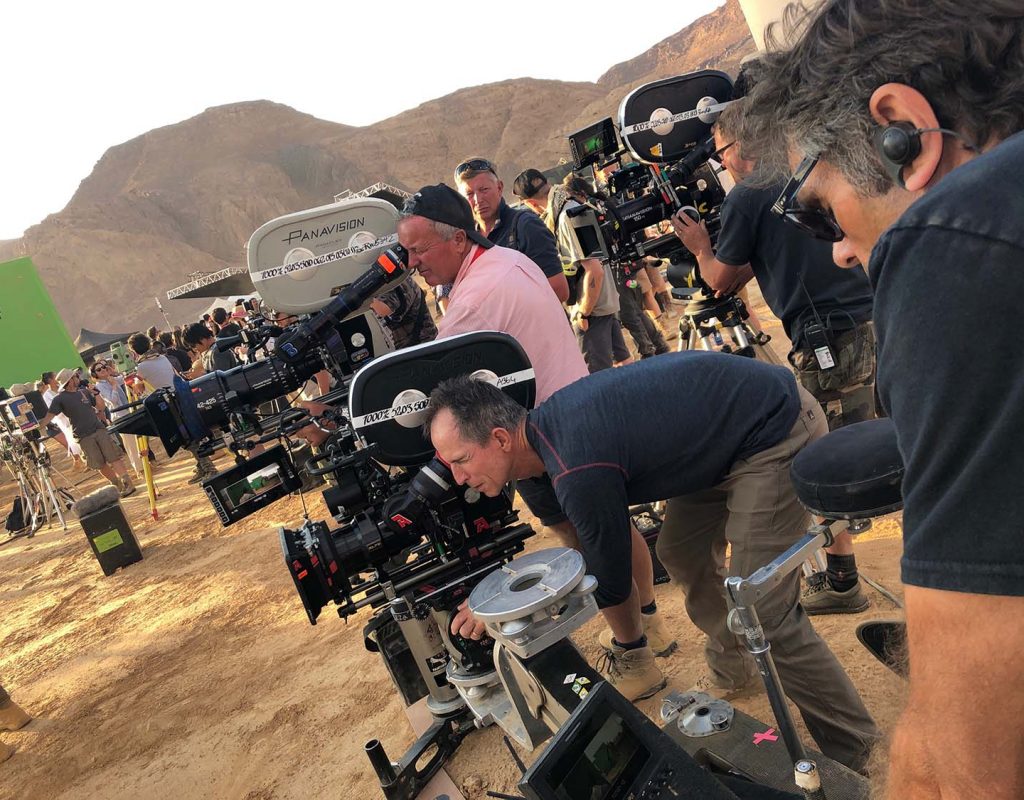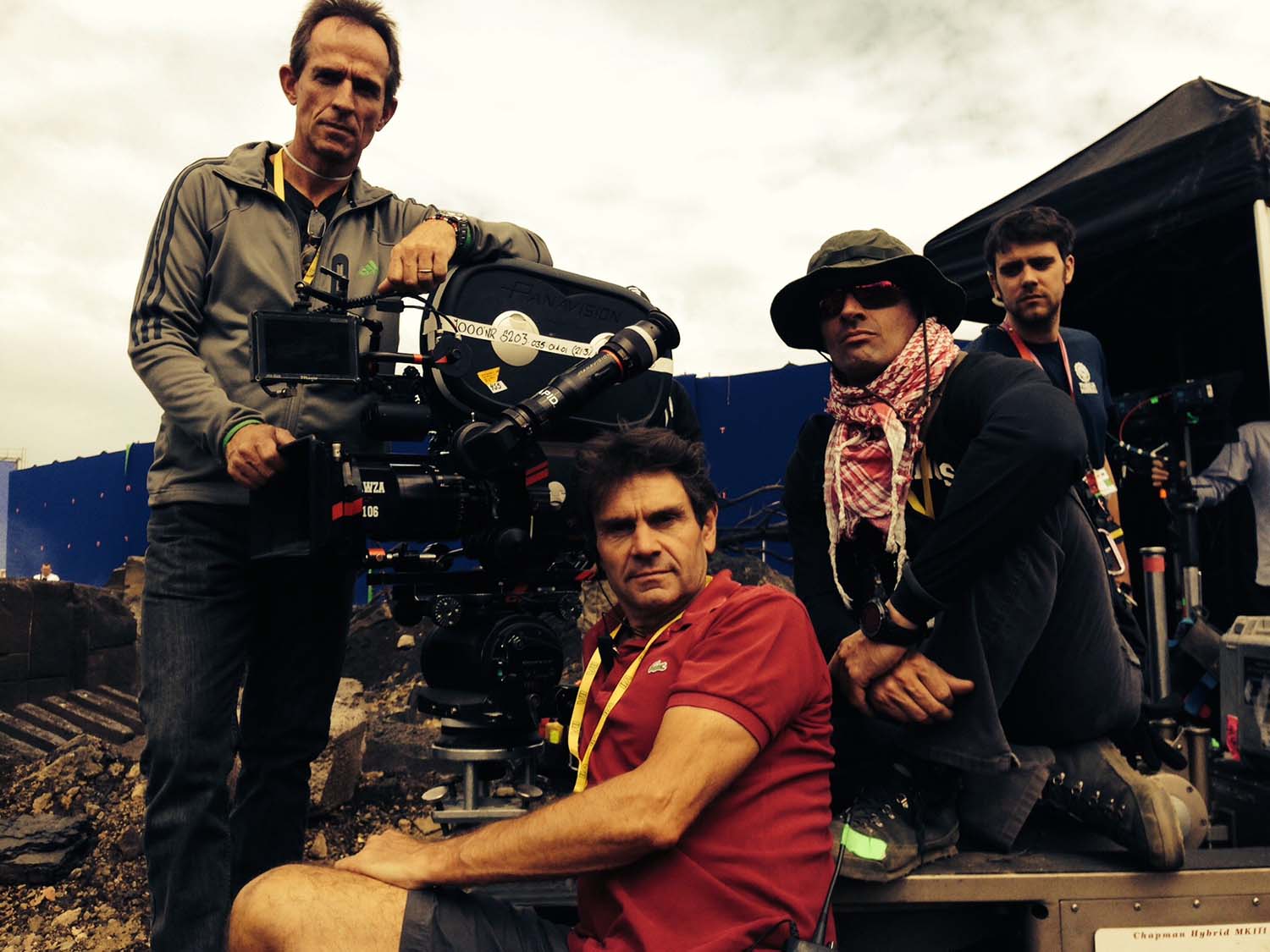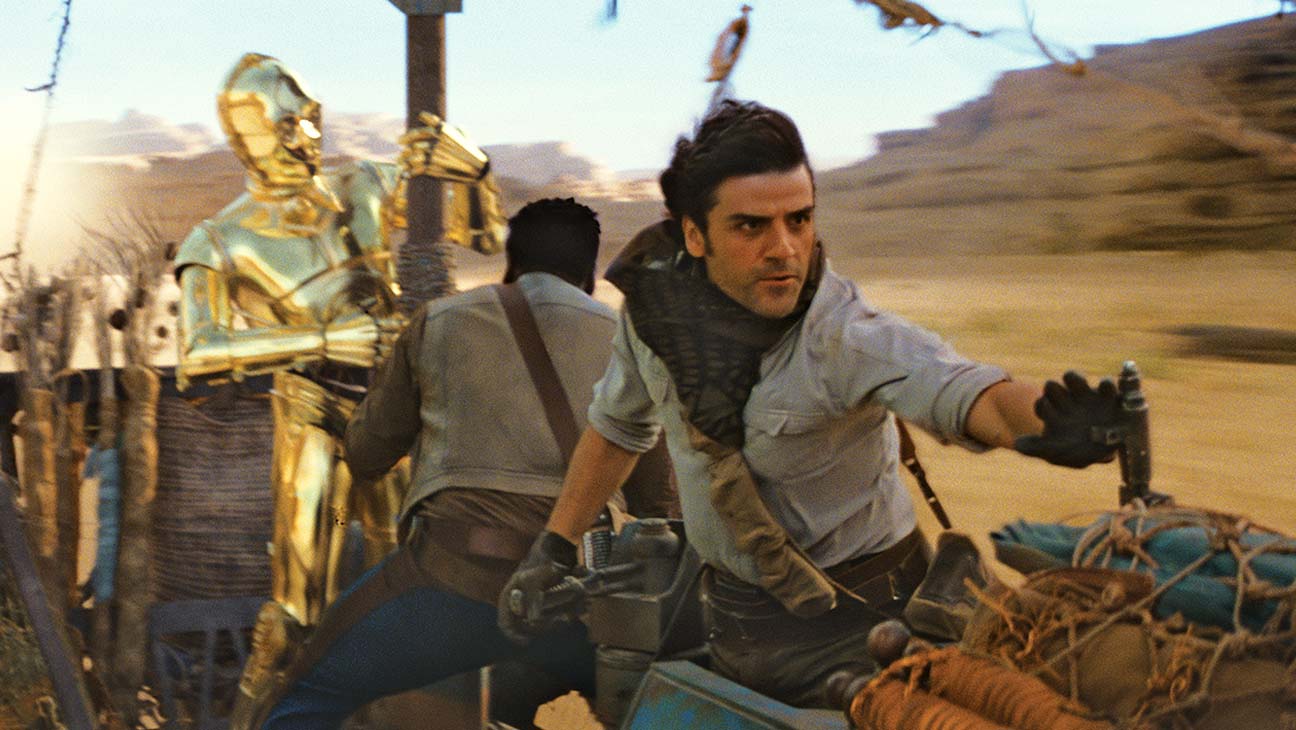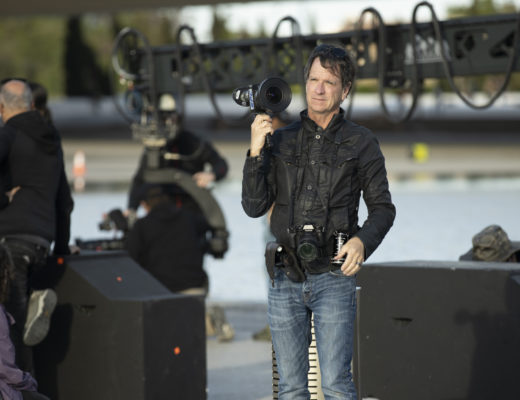
Colin Anderson, SOC is a camera operator and Steadicam operator who has shot some of the biggest and most-acclaimed films in recent years. You’ve likely seen and been moved by his work on the films of Paul Thomas Anderson, including There Will Be Blood, The Master, Inherent Vice, and Phantom Thread. Other films he’s shot include Syriana, the first two Iron Man films, The Town, Live by Night, Martin Scorsese’s Silence, as well as every one of J.J. Abrams’ films, including his most recent, Star Wars: The Rise of Skywalker.
This January, Mr. Anderson was honored by the Society of Camera Operators with a Lifetime Achievement Award. In this exclusive three-part interview, I sat down with him at his home in Los Angeles to discuss working as the “A” camera operator on the latest, and likely last, film in the Star Wars saga. Read on to learn about that, his perspective on the craft of camera operating, and what he’s learned from his career working with top actors and directors.
Click for Part 2 of our conversation. And look for episode 1 of the Art of the Shot podcast to hear the full conversation. Available now on your favorite podcast platform.
Derek Stettler: This year, you’re being honored with a Lifetime Achievement Award by the Society of Camera Operators, congratulations!
Colin Anderson: Thank you very much.
Stettler: You’ve had an incredible career working with incredible directors across the years and I want to be sure we discuss how your career began and what you’ve experienced. But first, I want to know what it takes, from your perspective, to operate at the level that you do. What makes a great camera operator?
Anderson: It’s not the easiest question to answer because there’s so many facets to camera operating, and I’m not sure there’s one or two particular talents or things you can do that will make you a great operator. I think what’s extremely important is personality. You have to be someone that people can get along with on set. You’re a diplomat, you’re a mediator, you’re often running the set to a small extent. You’re dealing with a lot of personalities. And I think it’s important to try to lead the set with humor, and with good spirits. In my experience, you always get more out of people when you ask nicely and there’s a good energy around. There’s a lot of people that are good operators that can get a bit aggressive about things. But I often think that if someone is going to pick up the phone and call X or Y about a job, they could call either. If X is as good as Y, but X is easier to get along with, they’re the ones that are going to get the job. So personality plays a large role in whether you get a job or not. Describing how to be a good operator is hard for me as well because I find so much of what I do is instinctual. I don’t think you can necessarily learn camera operating. It comes from what feels right to you. Sure, we often get the benefit of rehearsals, and the first couple of rehearsals are often bad as you learn what to do. If you’re doing a whip pan, working with J.J. Abrams you do a lot of whip pans, you would rehearse it three to five times before you roll just to set that into your muscle memory. But you can’t really learn too many things. There’s little tricks of the trade that you pick up over the years by having come up through the ranks, watching other operators that you were assisting, how you position yourself on the dolly, how you set up your camera head. But a lot of it is also so personal. I do a lot of work with Robert Elswit, and he’s an amazingly good operator. One of the best I’ve seen. Yet he’ll often have his geared headset at number three on the speed. And that stuns me, because I can’t do that at all. I go to third gear maybe once a year. Whereas Robert does that all the time. So he’s not wrong, I’m not wrong, it’s just a feel and a personal preference.
Stettler: So in that example, what about a three doesn’t feel right to you?
Anderson: It’s just too responsive for me. The slightest movement of your hand will move the frame. Maybe I’m not subtle enough for it, I don’t know. Using a fluid head, a lot of guys have an extremely light resistance, which is not my personal preference. I like it to be fairly stiff. But there’s not a right or wrong answer there.
Stettler: Well that shows that to even get to your level, you don’t need to have the steadiest hand in the business. It’s about more than just whether you can make the camera smooth and make the shots absolutely precise on call.
Anderson: Absolutely. I think communication is also tremendously important in camera operating. You’re communicating with your dolly grip, who is the operator’s best friend and one of the unsung heroes on the set. They are, in my opinion, our equals in terms of operating. So often, the dolly grip is doing all the heavy lifting, and I don’t mean that in the physical sense, I mean that in the way that they put the camera where it needs to be through their own skill and instinct, because they’re the ones actually moving the camera and often we’re just along for the ride. Having a great dolly grip is absolutely invaluable because they can bury you or lift you up. A great dolly grip can make an average camera operator look good. Whereas a great camera operator cannot really make a dolly grip look good.

Stettler: So on “The Rise of Skywalker”, and on the first film in the new trilogy, “The Force Awakens”, who was your dolly grip? Was it the same on both films?
Anderson: Fortunately, yes. It was a guy called Gary Hymns, one of the most extraordinary people around. He is so talented. And to get back to the personality thing, he’s probably got one of the greatest personalities I’ve ever come across. Gary is an artist in every sense of the word. He can move the camera in ways that very few dolly grips can. He’s got such a sense of timing and feel and I’ve seen him go from one end of the scale with J.J., where the camera is often flying around at high speed, to the most intimate, subtle moves that you can imagine. And he does it with an unfailing sense of humor. It’s one of the greatest privileges I’ve had to work with someone like that well.
Stettler: And as the other key component of the camera team, the 1st AC, who did you work with on this film? And was it the same person on both “The Force Awakens” and “The Rise of Skywalker”?
Anderson: Yes, it was the same on both films, Sergius Nafa. I was a 1st AC for 10 years before I moved up to operating, and I know how hard it is. I know it’s the hardest job on set and probably the least understood job on set. And with a director like J.J., it takes it to the next level. The camera is always flying in, pushing into minimum focus. It just never ends with J.J. There’s never an easy shot with him. The work that I saw Serge do on The Rise of Skywalker was just out of this world. He’s extraordinary. And you have to meet Serge to know him, but he’s very quiet, extremely low key. Never makes a fuss about getting marks or how hard a shot is. He’s almost invisible at times. But he’s always present. He’s always paying attention, and he’s world-class, he really is.
Stettler: The skill needed to become a first AC is something people really don’t acknowledge much.
Anderson: It’s extraordinary. And to take it even a step further, we shot these films on film. And the video taps are okay, but they’re not brilliant, you can’t really tell critical focus. And basically, you’re committing to work and moving on, not knowing whether you’ve got it 1,000% until you see it the next morning in dailies.
Stettler: And on a film the scale of “Star Wars”, that must be it nerve-racking.
Anderson: Yes, it amps up the pressure a trillion times. And that’s one of the reasons why I gave up focus. I just got sick and tired of having a knot in my stomach every night. I gave up focus before the digital world came into being, when you just never knew whether you achieved a difficult shot or not until you saw it the next day. And I think one of the last shots I ever did as a focus puller was on a movie called Up Close and Personal. …At the end of the film, I just thought to myself: ‘This is probably my last movie as a focus puller. I’m going to do something easier, like camera operating.’ [Laughs]

Stettler: So tell me, how did you become a camera operator? And you’re not just a camera operator, you’re also a Steadicam operator, which people don’t necessarily realize are often two distinct jobs.
Anderson: Yes, they are. I started back in South Africa in 1982, beginning at the South African Broadcasting Corporation, which had a film unit then. In those days, they used to shoot the majority of their work on 16mm film, and I went through their training program and became an assistant and eventually worked my way up to shooting news and sports. I did that for a couple of years and then I wanted to get into the big leagues, I wanted to be a part of what Hollywood was doing. I knew that there was a film business in South Africa that was small, but there were some extremely good people working in it, and I talked my way into that. Having been shooting stuff on 16mm, I stepped back down again to become a P.A., just to try and break into that world. It was a humbling move, I have to say. I remember sweeping floors and cleaning out spit buckets and things like that as a P.A., but it was something that you had to do. Luckily, it wasn’t for too long, and then I became a 2nd AC, and then moved up to focus pulling. South Africa had a fairly small film industry, and I was lucky enough to be able to break into the upper echelon fairly quickly, because it wasn’t a giant industry like it is in the United States. So I worked with some fantastic people and the last film I worked on as a focus puller in South Africa was A Far Off Place, a co-production between a South African company and Disney. We were the B camera guys, and they brought out all the A camera guys from the US, and I met some amazing key people on that set, people that are still pretty big in the industry here today. And, I said to them: “I want to come to the States.” And with incredible generosity, they all said to me, “If you come to the States, get in touch with us, and we’ll try and give you a leg up.” And that’s exactly what they did.
I came here having contacts. But I’m also leaving out one of the most important people in my career, which was Chris Harhoff. I’d always been very close friends with him, and I knew he was in the film business in the US. He’d moved here from South Africa two years prior to me moving here. He was one of the early Steadicam pioneers, so when I decided to come over, he said he’d help me. So I got over here and stayed with him for a couple of months, and started assisting him, which is how I got into the union. We did a film called Stargate, and Chris was the B camera operator and Steadicam, and I was his 1st AC. It started off non-union to build the sets and the day we started principal photography, it went union because it was just too big. As a result, I got into the union pretty early on in my stay in the U.S.
Stettler: When we first met and I asked you what it takes to be a top camera operator, you said luck. So this is part of what you were talking about.
Anderson: It’s all luck. It’s so weird to look back at your career, and you just have to marvel at the avenues and the paths that you’ve traveled. It’s quite extraordinary. But anyway, I assisted Chris for a couple more years, with the last film being Up Close and Personal. And during that film, I told him I was interested in becoming a Steadicam operator. And he mentored me and taught me how to do Steadicam. So I made the move at the end of that movie, and the DP on the film was this wonderful man named Walter Lindenlaub, who I’d done about four pictures with as a 1st AC. So when I decided to go to Steadicam, he said to me, “Listen, Colin, I can’t employ you as an operator. You’ve got to go away for a year or so and learn the ropes.”
Stettler: So what counts as you having learned the ropes?
Anderson: So this is slightly embarrassing, but also hugely important. One of the first things I did when I started operating was a small film called Cellblock Sisters Banished Behind Bars. It was one of those sorts of low-budget movies about girls in prison and they had the obligatory shots of breasts and things like that, but it was by no means pornographic. Anyway, I got paid $100 a day for my operating and my equipment. I had bought a Steadicam rig at that point and they were so excited for such a small production to have a Steadicam. So we literally did every single shot of this whole movie on the Steadicam. I wore the Steadicam for 12-13 hours a day. And it was absolutely invaluable, because you’ve got a camera, you’ve got a set, you’ve got actors. What more can you ask for? So that was massive. And I did a couple other things that year and then at the end of the year, Chris Harhoff was supposed to do a movie called The Jackal. It was a big film at the time, and Walter Lindenlaub was shooting it as well. Chris had to pull out at the last minute, so Walter called me and asked if I wanted to do it as the B camera/Steadicam operator.
Stettler: Had he seen the film you operated on?
Anderson: I don’t think so. But I’d been away for a year, so he said, “Okay, do you want a shot?” And I said, “I’d love it.” But because I was so new, he said, “I can’t protect you. I can’t fight for you. If you swim, you swim, if you sink, you sink.” I managed to make my way through it, and I went on to do another three or four films with Walter, as his A camera operator after that. Walter was massively instrumental in giving me my first break as an operator.

Stettler: So I want to talk about how you connected with J.J. Abrams, because you’ve been the camera operator on his films for many years now and that seems like a partnership where he particularly wants to have you. But before we do, you mentioned having the Steadicam on and you’re operating with it for at least 12 hours a day. I’ve spoken with other camera operators who used to do Steadicam and no longer do, just because it was very hard on their bodies. They had some knee surgeries, things like that. You seem to be in perfectly healthy shape, and you’ve been doing it for a long time. So what do you do to make sure that you’re able to perform, do the job, and be healthy?
Anderson: I’ve been enormously fortunate that I haven’t had any injuries throughout my career. My knees and my back and everything are still in great condition. I’ve always been reasonably athletic. I played a lot of sports in my youth and I think that’s helped me. I think you have to be fairly athletic and coordinated to do Steadicam, but I’ve been lucky enough never to have blown a knee out through anything else. I think if you go snow skiing and you tear your ACL, that’s a career-ender. But as I’ve got older, I’ll be 60 next year, I pay more attention to my body. I’ve started doing yoga, which I think is absolutely amazing. And then something else called TRX. When I’m working, I never exercise at all because generally I’m too tired and the hours are too long, but in between movies I do three days a week of yoga and two days a week of TRX. Oh, and stretching. Stretch, stretch, stretch! I stretch as much as I can. I stretch on set all the time.
The older I get, the wiser I become as a Steadicam operator. Some people think it’s a cop-out, but if ever I can, I’ll use the Garfield mount and hard mount the camera onto a dolly. It saves you, and it’s also such a wonderful way to combine two pieces of equipment. If you have a Steadicam and a dolly and you’re on a studio floor or dance floor, to combine those two pieces of equipment lets you do amazing stuff. As an operator, I can be way more accurate. When you’re walking with a Steadicam, you’re introducing a lot more into the Steadicam through your body movement, whereas if you can hard mount it onto a dolly, you can be so much more accurate. Sometimes people think, “Oh, that’s cheating. You should be wearing it.” But I don’t think so. I think what’s most important is to get a good shot.
Stettler: Yeah, most of filmmaking is cheating if you think about it. You don’t shoot many of these shots for real and the goal is to have the best shot you can, however it’s achieved.
Anderson: Once or twice over the years, I’ve heard someone say, “You’re getting paid to wear the Steadicam. Why are you not wearing it, why are you putting it on the dolly?”
Because it’s better this way.
Stettler: And you’re also getting paid for your experience and your knowledge of how to get a great shot.
Anderson: Yeah, for sure.
Stettler: So, regarding your collaboration with J.J. Abrams on, what must be five films now, more than that, maybe?
Anderson: I think it’s six. Yeah. So it started off with me working with Dan Mindel on other films, starting with The Skeleton Key, where I was B camera and Mitch Dubin was the A camera operator. And Dan and I hit it off. He is such an amazing guy, also South African. Dan is an operator’s dream. He does a lot of things in the old-school British way where he’s in many ways the lighting cameraman, and he allows the camera operator to deal directly with the director. And even though he allows that, he’s still involved, but he places a large amount of responsibility on the operator to deal directly with the director. So when Dan got Mission Impossible III with J.J. Abrams, Dan persuaded J.J. to take myself and B camera operator Phil Carr-Forster onto the film. J.J. is extraordinarily loyal to his crew. J.J. loves Dan and has worked with Dan on every film that he’s done, and because I built up this relationship with J.J. as well, it’s just been a family since then. He’s such an extraordinary human being, and I’ve just been lucky enough to work with him. He’s probably one of the hardest directors to work for as well. You are challenged every single shot of the day, every minute of the day. You’ll start a shot with J.J. on a Monday morning, and when you finish the first setup, you feel absolutely drained physically and mentally, because it’s been such a tough shot. And then you think, ‘Okay, great, here we go!’ It’s so rewarding, but incredibly tough.
Stettler: And how does J.J. communicate the shots he wants to you? Does he use storyboards? Does he walk the set with you and move as if he’s holding the camera, or–?
Anderson: No storyboards with J.J. We don’t storyboard stuff because he’s the kind of director that needs to see things and feel them out and actually be there. So he doesn’t storyboard and he doesn’t really have a shot list either. When he gets onto a set, he’ll start walking around, and we all follow at a respectful distance and let him think it out. He’ll often use the Artemis iPhone app, to get an idea of the scope and lenses that he’s looking at. J.J. will sort of plot out a scene walking around and once he’s got it in his mind and solidified what he wants to do, he’ll start discussing it with myself and with Dan. We’ll discuss lenses and what he’s looking for in the shot, and then once he’s described it, I’ll start working with Dan and with the dolly grip. I’ll often use the video viewfinder to show everyone the size and the edges of the frame, which is enormously helpful to the gaffer so he knows where he’s safe for his lights. I’ll talk to Gary Hymns about where we’re going to put the track or where we’re going to put the Technocrane and what the move is. But it all stems from J.J. and how he communicates to us.
Sign up for our newsletter to hear when future articles go live!

Filmtools
Filmmakers go-to destination for pre-production, production & post production equipment!
Shop Now












